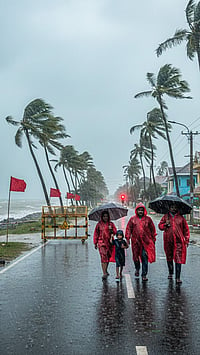Hurricanes are likely to become more frequent and intense in the North Atlantic Eastern Pacific Oceans over the next 10 years, according to a study by UK’s University of Reading. This increases the danger for coastal communities across North and Central America.
The study stated that tropical cyclone numbers in the Atlantic could more than double compared to 1970 levels, while East Pacific activity could increase by more than a third.
The total energy of these storms is also predicted to increase dramatically.
Rising Intensity
The University of Reading’s team used UK Met Office's DePreSys4 climate prediction software and a specialised tracking algorithm to forecast future hurricane patterns. In the North Atlantic, storm energy could rise to twice its 1970s levels, stated the study.
The study linked the predicted rise in hurricane activity to two key environmental factors, ocean surface temperatures and atmospheric wind patterns. The forecasting system shows that Atlantic Ocean temperatures are likely to be higher in the coming years, providing more energy for hurricanes to form and intensify.
At the same time, changes in wind patterns - particularly how winds vary at different heights in the atmosphere - are expected to create more favourable conditions for hurricane development. These changes are driven by a combination of natural climate variations and longer-term climate trends.
According to BBC, while assessing the exact reason for climate change on individual tropical cyclones can be challenging due to the complexity of these storm systems, rising temperatures affect these storms in various measurable ways.
Firstly, warmer ocean waters mean storms can pick up more energy, leading to higher wind speeds. Maximum wind speeds of hurricanes between 2019 and 2023 were boosted by an estimated 19mph (30km/h) on average as a result of human-driven ocean warming, as per BBC report.
Secondly, a warmer atmosphere can hold more moisture, leading to more intense rainfall. Climate change made the extreme rainfall from Hurricane Harvey in 2017 around three times more likely, reported BBC.
These findings underscore the urgent need for enhanced climate action to mitigate the impacts of more frequent and severe hurricanes. Strengthening coastal infrastructure, implementing effective disaster preparedness plans, and reducing greenhouse gas emissions are critical steps to protect vulnerable communities and ecosystems. Additionally, investing in sustainable energy sources and promoting climate resilience can help address the root causes of climate change, thereby reducing the severity of future hurricanes.
Additionally, an Intergovernmental Panel on Climate Change (IPCC) report stated that there is a “high confidence” that humans have contributed to increase in precipitation associated with tropical cyclones and “medium confidence” that humans have contributed to the higher probability of observed increase in Atlantic hurricane activity since the 1970s.
The world is already experiencing physical, financial and social impacts of extreme weather. It is imperative that global leaders acknowledge the climate reality and address the issues timely to avoid catastrophic consequences.





























